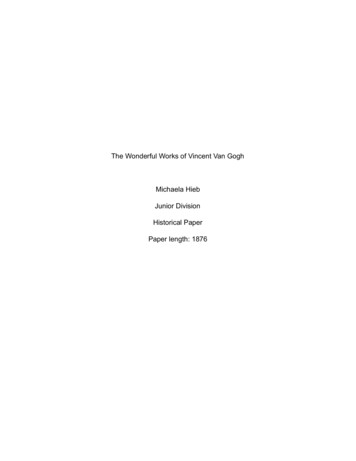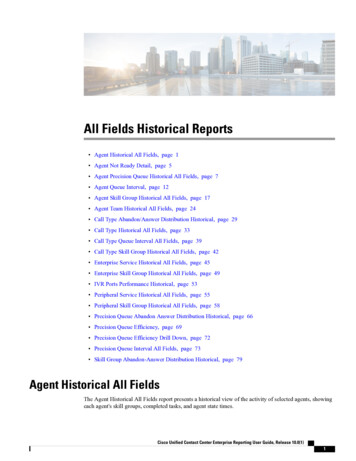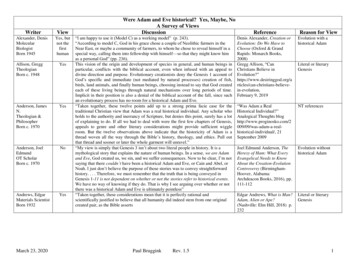
Transcription
The Wonderful Works of Vincent Van GoghMichaela HiebJunior DivisionHistorical PaperPaper length: 1876
2Vincent Van Gogh is one of the most famous artists in history, as well as one ofthe most influential. Because he painted with emotion and color and tried somethingnew, his legacy lives on through his art. Although Vincent Van Gogh lived a life full ofhardships including depression, his works of art have truly gained prestige and havechanged art in a positive way.Vincent Van Gogh was born on March 30, 1853, in Zundert, a town in theNetherlands. At sixteen years old, Vincent began working at the Hague Gallery ofFrench Art Dealers. Then, after being fired for his bad attitude, he began the process tobecome a minister, however later changed to become a priest. He was dismissed fromthis occupation at the beginning of 1876 at age 23 because he did not suit the job.1Vincent Van Gogh actually started to paint four years later in 1880, and in 1886 endedup moving in with his brother Theo. Paul Gauguin, another young painter in that era,noticed Vincent’s art in a display and respecting the style, he and Vincent soon becamegood friends. This new friendship, nevertheless, was a rather hard one to preserve, fullof tragic conflicts . Following one particularly large argument, Vincent Van Gogh cut off asegment of his left ear lobe and gave it to Rachel, a woman whom Gauguin visitedoften. Rachel then alerted the police who took Vincent to a nearby hospital to recoverfrom the severe loss of blood. In May 1889, Vincent Van Gogh was sent to an asylum inSaint-Remy, the townspeople not wanting to be near a proposed psychopath. During thetime he spent in that mental hospital, Vincent painted one hundred and fifty paintingsand produced hundreds of drawings, his art being his haven, an escape from his tragic1Heilbrunn Timeline of Art History.” The Met's Heilbrunn Timeline of Art History, 2000,www.metmuseum.org/toah/hd/gogh/hd gogh.htm.
3and lonely reality. Vincent Van Gogh was truly lonely all his life and made manyattempts at romance, however, all resulted in rejection.2 After this tragic life, on July 27,1890, Vincent shot himself and died two days later, at the young age of only 37 yearsold.Vincent Van Gogh’s art is a triumph because it changed art in a positive way, allbecause he tried something new. “This sovereign contempt for life, doubtless a result ofhis impetuous love of art, is extraordinary [.] If Vincent were still alive, it would takeyears and years until the human art triumphed. His death, however, is, so to speak, theglorious result of the fight between two opposed principles: light and darkness, life anddeath.”3 This quote is from a letter to Vincent’s brother Theo from Vincent’s caretakerDr. Gachet. It was sent a few days after Vincent Van Gogh died. Dr. Gachet is sayingthat Vincent Van Gogh’s artwork is astounding, and because of his hard work, and hiscaptivating inspirational story to go with it, art has developed and changed. The changeis what Dr. Gachet is referring to as triumph. Vincent’s hard work is also evident in manyother paintings, such as the Almond Blossom. When observing Vincent Van Gogh’sAlmond Blossom painting from 1890 [See Appendix A] you see that the shades arevibrant, and the image seems to rise off the page and come towards you. In thispainting, Vincent Van Gogh painted a beautiful Almond Blossom tree. Not only this butin I am Vincent Van Gogh by Gabriel Martin Roig, a book written through Vincent’sperspective states, “. the Impressionists. They were painters of light. Instead of usingstrong lines to make detailed paintings the Impressionists used only pure color to2Roig Gabriel Martín I, and García Fátima. I Am Vincent Van Gogh. Star Bright Books, 2017.3Roig Gabriel Martín i, and García Fátima. I Am Vincent Van Gogh. Star Bright Books, 2017.
4paint images I, however, did not want to be an impressionist painter. I adapted certaincharacteristics of the movement into my own work.”4 Vincent Van Gogh’s paintings weredifferent from the other art in his era. In Paris, the popular style during his time wasimpressionism. This is when painters used color rather than lines to create detail.Vincent Van Gogh adopted some of the impressionism painting strategies, but alsoimplemented his own ideas to the canvas, formulating his own unique style of art.Vincent is regarded as a Post-Impressionist painter. Post-Impressionism describes artfrom the late nineteenth and early twentieth centuries, concerning personal styles andnew importance of drawing. Vincent Van Gogh, Paul Gauguin, and Cezanne were theleaders in this time, creating and leading with a different style and purpose. Anotherexample of Vincent Van Gogh’s hard work is his painting Portrait of the Postman JosephRoulin [See Appendix B]. Vincent’s painting is of one of his close friends who wasstaying in Arles during 1888 and 1889. The different shades of blue in the coat createdepth, and whenA you look closely at the beard, you see all sorts of colors; green,yellow, and white to name a few. This painting is another excellent example ofpost-impressionism. While you see outlines of black in some areas, you see the purecolor contrast in other places. Vincent Van Gogh took parts of two different styles, andmerged them into one, producing a masterpiece, and a style that has been used bymillions of other famous painters throughout our history up until today, including a moremodern one, Bob Ross. Bob Ross was a much loved painter, and his style depictedmuch color and technique used in Van Gogh’s paintings.Vincent Van Gogh’s art is a triumph because he painted with emotion and color.4Ibid
5“Vincent expressed his life via his works. As he famously said, 'real painters do not paintthings as they are. they paint them as they themselves feel them to be.'"5 Vincent VanGogh not only merged styles of several artists to create his own, but he also paintedthings as he felt them to be. Vincent Van Gogh did not just apply the paint to the canvas.His unique method of Impasto, a technique of applying thick and visible strokes of paint,and his use of symbolic subjects, allow the observer to get a glimpse into Vincent’s life.Vincent’s works of art tell us just how tragic his life was. In a letter to his brother Theo,Vincent wrote, “‘As you can see, I am immersing myself in color—I've held back fromthat until now; and I don't regret it.’—Vincent van Gogh, The Hague, September 3,1882, to Theo van Gogh.”6 An article from the Denver Art Museum says, “Perhaps, butthen of course there is always van Gogh's color—the joyous application of pigment ontocanvas, the glorious use of impasto, thick and swift; that fabulous hatching technique, inplaces evoking the textures it depicts.”7 Vincent Van Gogh was not modest when itcame to painting. If he was creating something, he went all out with color. Vincentsuffered from depression, and often his facial expression in his self-portraits is dejected.Nevertheless, Vincent used vibrant colors and delicate brush strokes. He did not let hisdepression deter him from his passion. In another letter to Theo, Vincent wrote, “Ahwell, really we can only make our paintings speak.”8 In this quote, Vincent Van Gogh issaying that while communication with others is hard to do, you can make your art speakfor you. Art can contain emotions, whether it be through color, strokes, or symbolism. AnZurakhinsky, Michael. “Vincent Van Gogh Paintings, Bio, Ideas.” The Art htm.6Baer-Gutierrez, Fairlight. “20 Quotes from Vincent Van Gogh.” Denver Art logs/20-quotes-vincent-van-gogh7Baer-Gutierrez, Fairlight. “20 Quotes from Vincent Van Gogh.” Denver Art logs/20-quotes-vincent-van-gogh8“RM25.” The Letters - Vincent Van Gogh Letters, 2009, vangoghletters.org/vg/letters/RM25/letter.html.5
6example of symbolism is in Vincent’s painting The Bedroom At Arles [See Appendix C].An empty chair is depicted, portraying his loneliness. Vincent Van Gogh used all ofthese strategies to portray his emotions, and change the world for the better. Thefollowing is a description of Vincent Van Gogh’s painting, The Starry Night [See inAppendix D], “with intensely swirling patterns that seem to roll across its surface likewaves. It is packed with bright orbs—including the crescent moon to the far right, andVenus, the morning star, to the left of center—surrounded by concentric circles ofradiant white and yellow light.”9 Vincent Van Gogh said, “This morning I saw thecountryside from my window a long time before sunrise, with nothing but the morningstar, which looked very big.”10 Vincent Van Gogh’s painting of the Starry Night is unlikesome of his other paintings. While Vincent uses the same strategy of Impasto all aroundthe canvas, he surrounds the stars with a wight and yellow paint, creating a glowingeffect. While Vincent Van Gogh could have painted the small stars, he said that themorning star was glowing bright and that it was very big. Therefore, Vincent emphasizedthe stars even more with their halos.Vincent Van Gogh’s legacy lives on and has inspired many artists today, as wellas in the years closer to his death. “By the outbreak of World War I, with the discoveryof his genius by the Fauves and German Expressionists, Vincent van Gogh had alreadycome to be regarded as a vanguard figure in the history of modern art.”11 The wordvanguard means a group of people leading with new ideas. Vincent Van Gogh’s“MoMA Learning.” Lee Bontecou. Untitled. 1959 MoMA,www.moma.org/learn/moma 0“MoMA Learning.” Lee Bontecou. Untitled. 1959 MoMA,www.moma.org/learn/moma “Heilbrunn Timeline of Art History.” The Met's Heilbrunn Timeline of Art History, 2000,www.metmuseum.org/toah/hd/gogh/hd gogh.htm.9
7strategies were very different at the time and not only this but later on, they were usedby the Fauves and German Expressionists, and many after them. Vincent Van Gogh,without knowing it, started a huge chain of change in the art industry. With his boldapplications of color to the canvas, Vincent sparked something big. “In popular culture,his life has inspired music and numerous films, including Vincente Minelli's Lust for Life(1956), which explores Van Gogh and Gauguin's volatile relationship.”12 Vincent VanGogh not only gifted us with his astounding works of art but his legacy, his story, thathas inspired many. “Lust For Life” is a movie, starring Vincent Van Gogh and his friendGauguin. Not only this, but Vincent Van Gogh’s art was featured in other films such as“Midnight in Paris.” Vincent Van Gogh is an inspirational person in our history, his storyknown by millions and millions. Vincent Van Gogh has passed down his art along withhis style to everyone in the generations after him. He has gifted us with masterpiecesthat come with a very interesting story. Vincent Van Gogh is not only the subject ofmovies but a very powerful man who sparked change in the way art is created.Vincent Van Gogh had an extremely woeful life, but the product of this tragedy istruly a triumph. The artworks that Vincent has created were his creative escape from hisawful reality. In many of his paintings, he used symbolism, and the art style impasto,leaving people today to see what Vincent Van Gogh saw in the world. Although VincentVan Gogh lived a life of tragedy, full of arguments and much emotional pain, his worksof art are a triumph, his strategy of painting with emotion and color astounding, and hislegacy lives on, reminding us of his pure talent. Vincent Van Gogh instigated change inthe art community, causing art to look like it does today. Art now has more of a meaningZurakhinsky, Michael. “Vincent Van Gogh Biography, Life & Quotes.” The Art life-and-legacy.htm#legacy header.12
8to it, and everyone can paint their emotions, not just a Bible story. Vincent’s life teachesmany lessons, the most important, keep going even when times get tough, things willalways get better. As well as the famous saying, “Don’t judge a book by its cover.”
9Appendix A:Almond Blossom painted 1890Barnard, Marcel. “The Parable of Almond Blossom.” ArtWay.eu, 11 Apr. 2010,www.artway.eu/content.php?id 554&lang en&action show.
10Appendix B:Portrait of the Postman Joseph Roulin painted in 1888“Portrait of the Postman Joseph Roulin - by Vincent Van Gogh.” Chronology of VincentVan Gogh's Life and Works,2009, eph-roulin.jsp.
11Appendix C:Bedroom at Arles painted 1888“The Bedroom At Arles, 1888 by Van Gogh.” Chronology of Vincent Van Gogh's Life andWorks, www.vincentvangogh.org/the-bedroom-at-arles.jsp.
12Appendix D:The Starry Night painted 1889The Starry Night, 1889 by Vincent Van Gogh.” Chronology of Vincent Van Gogh's Life andWorks, www.vincentvangogh.org/starry-night.jsp.
13Primary SourcesBarnard, Marcel. “The Parable of Almond Blossom.” ArtWay.eu, 11 Apr. 2010,http://www.artway.eu/content.php?id 554&lang en&action show.This source provides a description of Vincent Van Gogh’s painting theAlmond Blossom. It also provides information about specific artists. I used thissource to prove that Vincent Van Gogh changed art.Baer-Gutierrez, Fairlight. “20 Quotes from Vincent Van Gogh.” Denver Art logs/20-quotes-vincent-van-goghThis webpage has 20 quotes from Vincent Van Gogh. Most of which arefrom letters to his brother Theo. The quotes describe his and the process that heused to create it. I used this source to help me prove Vincent Van Gogh paintedwith emotion and color.Bodinson, Sara. “MoMA Learning.” Lee Bontecou. Untitled. 1959 MoMA,www.moma.org/learn/moma n this article, the author, Sara talks about Vincent Van Gogh’s past andgoes on talking about his painting the Starry Night. Vincent Van Gogh paintedthis masterpiece in 1889. He wrote about this painting and his process to hisbrother Theo in one of his many letters. The article describes Vincent’s paintingin vivid detail, allowing a picture to be formed in the mind. This particular articlewas used in my evidence to prove that Vincent Van Gogh painted with emotionand color.
14Malyon, John. Artcyclopedia, is article provides much information as to what Paul Gauguin andVincent Van Gogh quarreled about. It also provides pictures of Van Gogh’spaintings. I used this source to learn more about Vincent Van Gogh and hisissues.“MoMA Learning.” Lee Bontecou. Untitled. 1959 MoMA,http://www.moma.org/learn/moma his source describes Vincent’s Starry Night. It also talks about his style. Iused this source to help me prove that Vincent Van Gogh painted with color.“Portrait of the Postman Joseph Roulin - by Vincent Van Gogh.” Chronology of VincentVan Gogh's Life and Works, -postman-joseph-roulin.jsp.This source has a list of paintings and a description of each. This site alsotalks about the reasons behind the paintings. I used this source to help me provethat Vincent Van Gogh’s art is a triumph because he changed art in a positiveway.“RM25.” The Letters - Vincent Van Gogh Letters, ter.html.This source provides many letters that Vincent Van Gogh wrote, not just tohis brother Theo, but to other people like his friend Joseph. I used this source toprove that Vincent painted with emotion and color.
15Zurakhinsky, Michael. “Vincent Van Gogh Biography, Life & Quotes.” The Art life-and-legacy.htm#legacy header.This website gave me more insight as to how Vincent Van Gogh’s legacy isliving on, as well as a timeline that helped me grasp when events happened inrelation to one another. This website also provided quotes from Vincent. I usedthis site to prove that Vincent Van Gogh’s legacy lives on.
16Secondary SourcesBarton, Gina. “Results for ‘Vincent Van Gogh.’” Vox.com, Vox Media, 15 July 2017, 9:40a.m., nt-van-gogh-travel.In this video, Gina Barton talks about Vincent Van Gogh’s tragic past. Whilewatching this video I learned the pathways Vincent Van Gogh took during hislifetime. He went many places because of his job at the Hauges Gallery, an artdealership, that transferred Vincent throughout France.Heilbrunn Timeline of Art History.” The Met's Heilbrunn Timeline of Art History, 2000,www.metmuseum.org/toah/hd/gogh/hd gogh.htm.This website provides more background information, as well as anexplanation pertaining to what influenced Vincent Van Gogh’s art. Not only doesit talk about Vincent Van Gogh’s life, but it talks about how people used his styleof painting in the past, how his legacy lives on. I used this website to prove thatVincent Van Gogh inspired many artists today, as well as closer to his death.
17Cruz, Sabrina, director. The Story Behind Famous Paintings. YouTube, YouTube, 28 Apr.2017, http://www.youtube.com/watch?v jND9DUcR6d4.This video by Sabrina not only provided information on Vincent Van Gogh’sStarry Night as well as parts of his life, but it also referred to paintings that cameafter Vincent Van Gogh. The Scream by Edvard Munch is particularly similar toVan Gogh’s style of painting, using swirls and different colors where only onewould seem present. This video helped me gain perspective on the halos aroundthe stars in Vincent Van Gogh’s Starry Night. Sabrina talks about Vincent eatingor trying to eat paint, and the effects of the lead inside the paint include swollenretinas, making halos appear around lights, similar to the effect in Vincent’spainting.Malyon, John. Artcyclopedia, html.This article provides much information as to what Paul Gauguin andVincent Van Gogh quarreled about. It also provides pictures of Van Gogh’spaintings. I used this source to learn more about Vincent Van Gogh and hisissues.Roig Gabriel Martín I, and García Fátima. I Am Vincent Van Gogh. Star Bright Books,2017.This book is written in the first person so that it is Vincent Van Goghtalking. It provides multiple sections, all about different parts of Vincent’s life. Iused this source to prove that Vincent Van Gogh’s art is a triumph because he didsomething new.
18Sal. “Realism, Impressionism and Post-Impressionism.” Khan Academy, Khan dern/avant-garde-france.This source helped me gain a better understanding of Impressionism,Post-Impressionism, and how Vincent Van Gogh was a part of it. Vincent saw thework of the Impressionists and was inspired. He took the style of theImpressionists, using color to create detail, and added it to his own way ofpainting, becoming a Post-Impressionist. I used this source to dig deeper into thestyle of Vincent Van Gogh.“Van Gogh.” Van Gogh, by Victoria Charles et al., Parkstone Press, 1997.This source has some of the paintings created by Vincent Van Gogh. Italso gives more insight as to Vincent’s life’s experiences. This source providedanother perspective to my research.Vanguard Definition of Vanguard in English by Oxford Dictionaries.” Oxford Dictionaries English, Oxford Dictionaries, ord Dictionaries provides definitions online. I used this source to helpunderstand the word Vanguard. This word changed my perspective on how Isaw Vincent Van Gogh. Vanguard means a group of people leading with newideas as well as developments.
19Zurakhinsky, Michael. “Vincent Van Gogh Biography, Life & Quotes.” The Art life-and-legacy.htm#legacy header.This website gave me more insight as to how Vincent Van Gogh’s legacy isliving on, as well as a timeline that helped me grasp when events happened inrelation to one another. This website also provided quotes from Vincent. I usedthis site to prove that Vincent Van Gogh’s legacy lives on.Zurakhinsky, Michael. “Vincent Van Gogh Paintings, Bio, Ideas.” The Art htm.This source has images of Vincent’s paintings with a description of eachas well as the year it was created. This website provides five quotes from VincentVan Gogh. I used this source to prove that Vincent Van Gogh painted withemotion and color.
Vincent Van Gogh was truly lonely all his life and made many attempts at romance, however, all resulted in rejection. 2 After this tragic life, on July 27, 1890, Vincent shot himself and died two days later, at the young age of only 37 years old. Vincent Van Gogh’s art is a triumph becau










